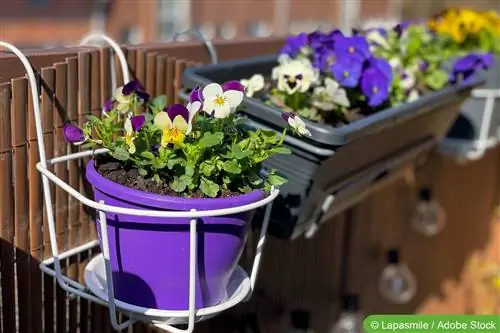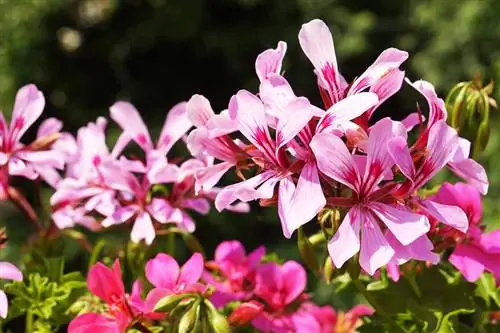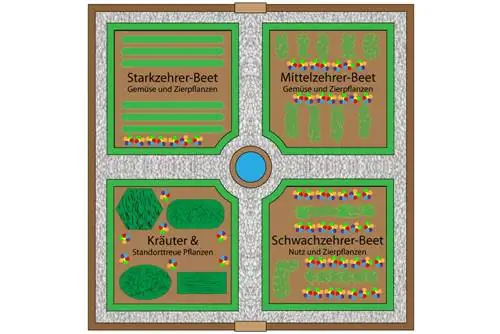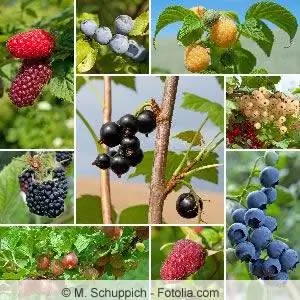- Author admin [email protected].
- Public 2023-12-17 03:39.
- Last modified 2025-06-01 06:48.
Plants in boxes - quite a few plants can be kept in appropriate planters both in the garden and on the balcony. The balcony and garden design can be implemented with relatively little effort and you also remain flexible thanks to the mobility of the pots.
The perfect time
If you want to have beautiful plants in the garden and on the balcony in planters throughout the summer, you should plant them at the right time. You shouldn't be impatient, because plants that are taken outside too early may get night frosts in the spring and then die. From May is the right time to devote yourself to planting pots for the garden and balcony without having to take the plants back into the house at night. By the way, daisies, begonias and geraniums in particular are just as popular plants in pots as they are also sensitive plants when it comes to cold temperatures.
Tip:
If you want to be absolutely sure and perhaps even want to use relatively sensitive plants, wait until the Ice Saints before finally planting the pots, because up to this point around mid-May it can still be too busy in our regions Night frosts are coming.
Plant only in clean containers
Before the pots are planted, they should be thoroughly cleaned. A hand brush is suitable for removing coarse dirt. After the planter has been freed from any major contamination, a damp cloth is used for final cleaning. Some containers that have already been planted have relatively stubborn limescale deposits. To remove these you can use a wire brush. Alternatively, the plant pot affected by limescale deposits is placed in a water bath that has been mixed with vinegar or citric acid. This means that even strong limescale stains can be easily removed.
The correct layering when planting
It is important when placing any plants in pots that they are protected from waterlogging. Some plants react very sensitively to waterlogging and die, but in any case, undesirable waterlogging affects the he althy growth of all plants. The first layer when the substrate is placed in the pot is a layer of expanded clay, which absorbs the excess water and keeps it away from the sensitive roots. The advantage of expanded clay is that it slowly releases the stored water back into the earth, especially on hot days.
A separating fleece is placed over the drainage layer so that the soil that is then filled in does not wash into the expanded clay drainage layer. Only now is the appropriate potting soil poured into the plant pot. It is a good idea to add a long-term fertilizer, such as compost, immediately when filling the container with soil. This ensures a consistent supply of nutrients to the plant, which ensures continuous and powerful flowering. As an alternative to compost, horn shavings, which are available at hardware stores or garden centers, can also be incorporated into the soil. If you take this precaution, you no longer have to worry about fertilizing your plants throughout the season. Layering the substrate correctly is called
- first drainage made of expanded clay
- then a separating fleece
- then pour potting soil mixed with slow-release fertilizer into the bucket
How to plant potted plants correctly
Before putting the plants in the pots, remove them from the plastic cups in which they were purchased. To do this, the cup is grasped and then squeezed in a few places. In this way, the root ball is released from the cup without damaging the delicate root branches. Now the stem of the plant is taken between two fingers and covered with your hand. The plant is then turned over and removed from the cup with a gentle pull. If the root balls are already heavily matted, they must first be carefully plucked apart. This is important so that the plant later roots perfectly in the substrate. Once the plants are in the right place in the container, the spaces are filled with soil, which is then lightly pressed down. It is important that there is about two centimeters of space left from the top edge of the soil to the end edge of the bucket for the irrigation water so that the bucket does not always overflow.
Watering correctly
While bedding plants can build up a reserve of water in the soil through intensive watering, potted plants for gardens and balconies require more sensitivity. Especially during the growing season in summer, the potted plants need to be watered moderately but regularly. Watering in the morning and evening is best, because when the temperatures are slightly cooler, the irrigation water penetrates into the soil, while in the hot midday hours it evaporates immediately on the surface of the soil and does not reach the roots. Soft, low-lime water is perfect, preferably from a rain barrel. Potted plants may only be watered on the ground, but not over leaves and flowers
Tip:
Always water potted plants slowly. Then the dried soil can absorb the water well, while when watering quickly it runs through the dry soil directly into the drainage.
Provide automatic irrigation for thirsty plants
Special plant pots are equipped with a double bottom and therefore have a water reservoir for the plant. Equipped with a water level indicator, the bucket shows when it is time for watering again. Alternatively, you can buy special containers that are filled with water and inserted into the soil, sporadically releasing the water into the substrate. There are also special flower boxes available in stores that, in addition to the double bottom, also have a side filler neck through which they are poured. By the way, these pots do not need to be provided with drainage before planting. Clay pots are also very good as plant pots because they soak up water and gradually release it to the plant. A quick and inexpensive solution is plastic water bottles that are filled with water and inserted upside down into the substrate. With this solution, the plant can be easily supplied with water for about a week without further watering - this watering is also ideal for shorter trips.
Choose the right plants for the pot
There are a wide variety of plants that you can put in pots and keep in the garden or on the balcony. The location of the garden or balcony is important for the selection, as this determines whether the plants should be more sun-hungry or whether more robust plants that can survive with less sun can be placed in the pot. Incidentally, both garden herbs and deliberately small vegetable and fruit plants that are decorative when kept in pots and promise a harvest are becoming increasingly popular. It is also important here to take into account the influence of the sun on the plants and their needs. If you prefer shade, you should choose plants such as ivy, fuchsias, primroses or boxwood and chrysanthemums. On the other hand, fruits and herbs, vegetable plants such as tomatoes or geraniums, dahlias or petunias can tolerate a lot of sun.
Frequently asked questions
How do I overwinter my potted plants?
In general, the plant should be overwintered according to its individual needs in terms of lighting conditions, room temperature and care. It is important for all potted plants that they are cleared of leaves, weeds and possible pests before they are sent into hibernation. Blossoming, diseased areas and dead wood are also removed before overwintering. This is the only way the plant can get through the cold season he althy and strong.
How do I protect my potted plants from pests?
In addition to good care, which strengthens the plant, many hobby gardeners also swear by an infusion of field horsetail, which gives the plants strength and thus protects them from pests and diseases.
Popular plants for gardens and balcony boxes
- Buddleia: The fragrant butterfly magnet is swarmed by butterflies of all kinds. Many varieties in blue, white and purple. Buddleia is suitable for the vase.
- Sun Bride: In numerous shades of yellow, orange and red, this flower miracle, which grows to a height of around 100 to 140 cm, provides color from August onwards. The sun bride is one of the most important color supports in the autumn garden. Despite its name, the North American prefers sufficient moisture.
- Sunflower: If you have a larger area available, you should sow the head-high sun worshipers at different times so that new flowers always decorate the vase.
- Coneflower: Safe starter perennial that you can't go wrong with. The carmine-red flower stars decorate beds and vases. Attractive fruit clusters.
- Flame flower: The upright ornamental perennial is the right flower material for representative beds. Varieties in white, pink and red grow up to 150 cm high. Ideal neighbors are chrysanthemums.
- Blue Rue: A blue wonder in the first year of gardening. The blue rue attracts many insects and, with its gray felt-like foliage, goes ideally with roses. Prefers sunny, bright locations.
- Prachtspieren: Astilbes love semi-shady locations. The wetter the soil, the more direct sun they get. White, red and pink varieties offer a rich selection to suit every taste. The finely feathered foliage underlines the graceful character of this border perennial.
- Dahlias: The selection of dahlia varieties is gigantic. They bloom reliably in any weather. In contrast to the many other spring-flowering bulbous and bulbous flowers, dahlias shine with many flowers in autumn.
- Autumn anemones: Excellent autumn bloomers for partially shaded locations. They also fit very well between trees and create highlights even in northern locations. Autumn anemones grow to a height of around 100 cm. They bloom in many shades of pink and white until the first frost.
- Chrysanthemums: Well-known cottage garden perennials that organize a late blossom festival in red, yellow and pink with large flower plates in bright colors. Prefers sunny locations.






